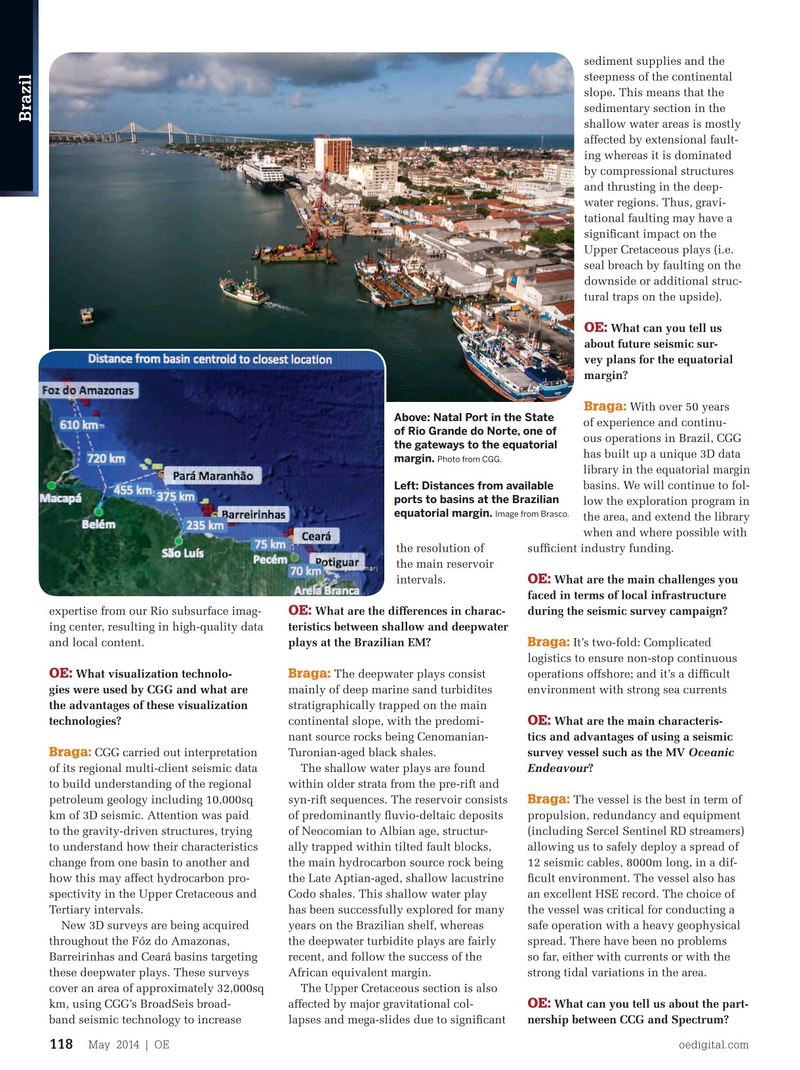
Page 116: of Offshore Engineer Magazine (May/Jun 2014)
Read this page in Pdf, Flash or Html5 edition of May/Jun 2014 Offshore Engineer Magazine
sediment supplies and the steepness of the continental slope. This means that the sedimentary section in the
Brazil shallow water areas is mostly affected by extensional fault- ing whereas it is dominated by compressional structures and thrusting in the deep- water regions. Thus, gravi- tational faulting may have a signifcant impact on the
Upper Cretaceous plays (i.e. seal breach by faulting on the downside or additional struc- tural traps on the upside).
What can you tell us
OE: about future seismic sur- vey plans for the equatorial margin?
With over 50 years
Braga:
Above: Natal Port in the State of experience and continu- of Rio Grande do Norte, one of ous operations in Brazil, CGG the gateways to the equatorial has built up a unique 3D data margin. Photo from CGG.
library in the equatorial margin basins. We will continue to fol-
Left: Distances from available ports to basins at the Brazilian low the exploration program in equatorial margin. Image from Brasco.
the area, and extend the library when and where possible with the resolution of suffcient industry funding.
the main reservoir
OE: intervals. What are the main challenges you faced in terms of local infrastructure expertise from our Rio subsurface imag- What are the differences in charac- during the seismic survey campaign?
OE: ing center, resulting in high-quality data teristics between shallow and deepwater
Braga: and local content. plays at the Brazilian EM? It’s two-fold: Complicated logistics to ensure non-stop continuous
OE: Braga: What visualization technolo- The deepwater plays consist operations offshore; and it’s a diffcult gies were used by CGG and what are mainly of deep marine sand turbidites environment with strong sea currents the advantages of these visualization stratigraphically trapped on the main
OE: technologies? continental slope, with the predomi- What are the main characteris- nant source rocks being Cenomanian- tics and advantages of using a seismic CGG carried out interpretation Turonian-aged black shales. survey vessel such as the MV Oceanic
Braga: of its regional multi-client seismic data The shallow water plays are found Endeavour?
to build understanding of the regional within older strata from the pre-rift and
Braga: petroleum geology including 10,000sq syn-rift sequences. The reservoir consists The vessel is the best in term of km of 3D seismic. Attention was paid of predominantly fuvio-deltaic deposits propulsion, redundancy and equipment to the gravity-driven structures, trying of Neocomian to Albian age, structur- (including Sercel Sentinel RD streamers) to understand how their characteristics ally trapped within tilted fault blocks, allowing us to safely deploy a spread of change from one basin to another and the main hydrocarbon source rock being 12 seismic cables, 8000m long, in a dif- how this may affect hydrocarbon pro- the Late Aptian-aged, shallow lacustrine fcult environment. The vessel also has spectivity in the Upper Cretaceous and Codo shales. This shallow water play an excellent HSE record. The choice of
Tertiary intervals. has been successfully explored for many the vessel was critical for conducting a New 3D surveys are being acquired years on the Brazilian shelf, whereas safe operation with a heavy geophysical throughout the Fóz do Amazonas, the deepwater turbidite plays are fairly spread. There have been no problems
Barreirinhas and Ceará basins targeting recent, and follow the success of the so far, either with currents or with the these deepwater plays. These surveys African equivalent margin. strong tidal variations in the area.
cover an area of approximately 32,000sq The Upper Cretaceous section is also
OE: km, using CGG’s BroadSeis broad- affected by major gravitational col- What can you tell us about the part- band seismic technology to increase lapses and mega-slides due to signifcant nership between CCG and Spectrum?
May 2014 | OE oedigital.com 118 116_OE0513_Brazil1_EqMargins.indd 118 4/19/14 10:05 AM

 115
115

 117
117